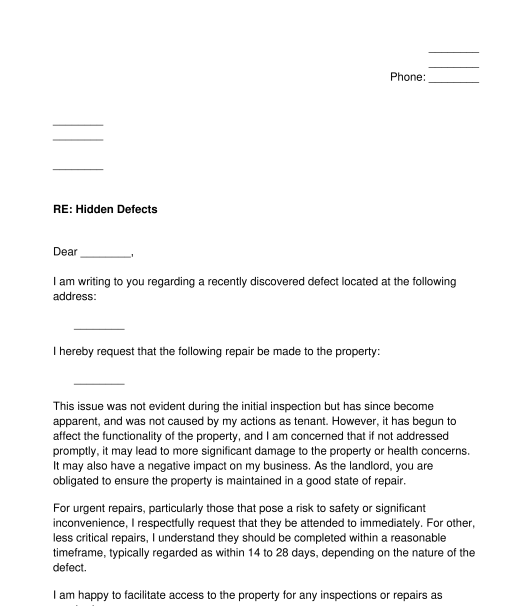 10/10/2025
10/10/2025

Answer a few questions and your document is created automatically.

Your document is ready! You will receive it in Word and PDF formats. You will be able to modify it.

 10/10/2025
10/10/2025
 Word and PDF
Word and PDF
 1 page
1 page
This Letter Reporting Hidden Defects in a Commercial Property is tailored for use in relation to commercial properties within Australia. It serves as a formal notification from a tenant to their landlord or property management company, detailing hidden defects or issues that have surfaced in the leased commercial space. This document is essential for tenants who come across problems that were not evident during the initial inspection or that have developed over time.
The letter can be used to document specific defects identified within the property, such as issues with plumbing, mould, electrical faults, or any structural damages that have become apparent after the commencement of the tenancy. It acts as an official record of the tenant alerting the landlord about these concerns, necessitating appropriate action for their rectification.
This document is not intended for use with residential properties. If a tenant wants to report hidden defects with a residential property, they may use our Letter Reporting Hidden Defects in a Rented Property.
This document is designed for tenants wishing to inform their landlords or property management companies about hidden defects in the commercial property they rent. The letter should be addressed to the landlord or the property management firm and should include a detailed description of any defect(s) which the tenant has identified. It should also include some information about how the tenant thinks it should be resolved (such as whether the landlord should fix it, or the tenant plans to fix it).
Upon completion, the letter should be printed and signed by the tenant. It can then be posted to the landlord, property manager, or maintenance team. Alternatively, it may be saved as a PDF and emailed to the relevant parties.
It is prudent for the tenant to retain a copy of the letter for their records, noting the date it was dispatched. This is particularly crucial if the tenant intends to use the letter as evidence that the landlord was notified of the issue before the tenant proceeded with any actions (such as arranging repairs themselves).
Moreover, if the tenant plans to use the letter as proof of notifying the landlord before taking any further steps, then careful consideration should be given to the recipient of the letter. The lease agreement may specify the appropriate recipient. For instance, if the lease dictates that notices must be sent to the landlord, but the tenant has been directly communicating with a maintenance team, a copy of this letter should also be directed to the landlord (even if another copy is sent to the maintenance team).
In Australia, tenants' rights, including minimum standards for the maintenance of commercial properties, are governed by Commonwealth and State legislation. For further information on the laws pertinent to a specific area, it is advisable to contact the local tenants' association, tenancy support office, fair trading office, or community legal centre. If uncertain, seeking legal advice is recommended.
You fill out a form. The document is created before your eyes as you respond to the questions.
At the end, you receive it in Word and PDF formats. You can modify it and reuse it.
Country: Australia